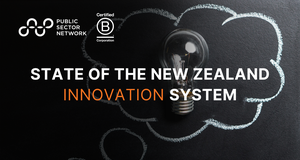If you missed it – last week’s article delved into the importance of mental health in the public workplace. When it comes to mental health, there is no distinction between senior and junior staff. It affects everyone. As such, Leanne Perryman says that a lot of their focus has been on “reducing the stigma of mental health in our workplace.” One of the activities that has worked well was getting people to tell their own stories. Others listened and also shared their stories or sought help. One of the things that triggered this was ‘R U OK Day’, but we now have regular “mental health check-ins. When teams get together, they talk mental health, not just once a year.”
“We very much recognise that wellbeing is a personal responsibility, but as an organisation we also recognise that leaders have a role in creating an environment that enables healthy wellbeing.”
Leonie Graham says that for them, ‘R U OK Day’ also sparked “a theme of keeping the conversation going. It wasn’t just a one-off training session or a Band-Aid solution.” It was about a continuous approach to supporting people in whatever way was necessary for them. As such, it was also very much “a two-way conversation.”
“It is important to help your leaders understand that the value you’re going to get and provide by having mental health training and programs, is going to greatly outweigh any time or investment commitments. This is true for the people establishing them and especially for the people participating in them.”
Keep conversations flowing
The true value is in keeping the conversations going. At IP Australia for instance, “81% of survey respondents agree that we’re doing a good job in communicating our health and wellbeing initiatives.” This is “significantly greater than the APS (Australian Public Service) average.” Wellbeing on a group and individual level is important and “the investment is always justified.” Moreover, “building trust within the organisation and having a champion” has really worked for them. They are talking and having conversations, but are also “delivering genuine programs trusted by our employees.”
Leanne Perryman says that they too justified their investment and “implemented some technology tools that all of our staff have access to.” The training is to deal with the effects of mental health, but also to assist in preventing it. “We want to make sure that wellbeing is part of our leadership and training DNA,” and because they started some of this before COVID-19, “we were well positioned when the pandemic struck, but we also implemented extra wellbeing breaks to make people feel better at work.” At their workplace, wellbeing is now becoming part of the DNA, but that is only because “we have buy-in from the top and a genuine intention to improve people’s workplace settings and create a climate that supports their wellbeing.” If the support from all levels is not present, it will be hard to be successful. “It’s not just a nice, warm and fuzzy thing that we want everyone to feel. We want people to perform at their best, and to do that, they need to be well and they need to be supported.”
Abbey Kinnane says that when it comes to wellbeing, “it’s really important that we show authenticity when we’re developing programs or activities.” In many ways, wellbeing in the workplace is about “creating a sense of connection and purpose, and doing it with passion.”
“For me, wellbeing in the workplace is essentially about creating a safe environment for yourself and your staff, being able to be vulnerable, and having authenticity in everything that you do.”

















